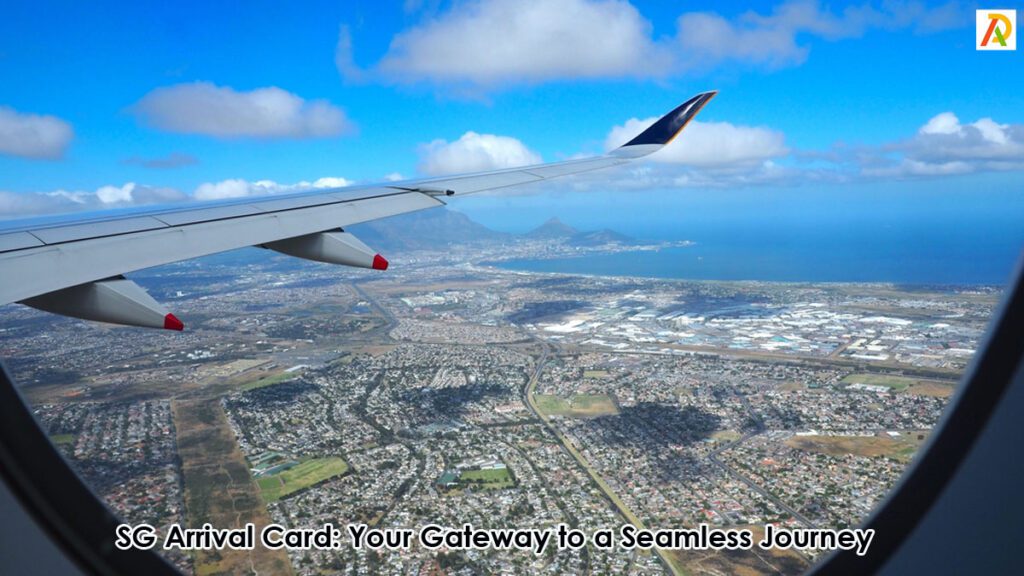SG Arrival Card: Your Gateway to a Seamless Journey

When embarking on an exciting journey to Singapore, one essential document that every traveler should have acquaintance with is the SG Arrival Card. This card, often referred to as an Entry Card or Disembarkation Card plays a crucial role in ensuring a smooth and hassle-free entry into this vibrant and captivating city-state. In this comprehensive guide, we will delve into the intricacies of the Singapore Arrival Card, covering its purpose, requirements, eligibility criteria, validity, application process, and cost. Furthermore, a few extra travel tips will make your Singapore adventure truly unforgettable.
What is a Singapore Arrival Card?
The Singapore Arrival Card is a mandatory immigration form that all travelers have to complete before entering Lion City. This document serves as a vital part of Singapore’s immigration control and customs clearance processes. It enables authorities to gather essential information about visitors and their intended stay.

Prerequisites for Singapore Arrival Card
To complete the Singapore Arrival Card, travelers need to provide accurate and up-to-date personal information. This includes their full name, passport details, flight information, intended address in Singapore, and the purpose of their visit. All information provided on the card must match the details on the traveler’s passport and other travel documents.
Who Requires an SG Arrival Card?
The Singapore Arrival Card is obligatory for all incoming travelers, regardless of their nationality, age, or purpose of visit. Whether you’re arriving for leisure, business, or a layover, this document is an essential requirement for entry into Singapore.
Validity of a Singapore Arrival Card
The SG Arrival Card is typically valid for the duration of the traveler’s stay, as indicated on their immigration pass or visa. Visitors must ensure that their Arrival Card remains with them at all times while in Singapore. They should be ready to present it to immigration authorities upon request.
How Long Does It Take to Obtain an SG Arrival Card?
The process of obtaining a Singapore Arrival Card is relatively straightforward and efficient. Travelers often receive the Arrival Card form during their flight to Singapore. It is advisable to complete the card while on the plane to expedite the immigration process upon arrival. This proactive approach can help minimize wait times at the airport. It also allows you to begin your Singaporean experience promptly.
What is the Cost of the Singapore Arrival Card?
The Singapore Arrival Card itself does not incur any direct charges. Singaporean authorities typically provide it to travelers as part of the immigration process, without an additional fee. However, it’s essential to be aware of any potential visa fees or entry requirements that may apply based on your nationality and the purpose of your visit.
Things to keep in mind while submitting the SG Arrival Card
As of the latest knowledge update in September 2021, the SG Arrival Card (also known as the Disembarkation/Embarkation Card or DE Card) is a document that travelers must fill out upon arriving in Singapore. Please note that procedures and requirements might have changed since then, so it’s essential to verify the latest information from official sources before your trip. Here are some general tips that were relevant up until September 2021:
- Accurate Information: Ensure that all the information you provide on the Arrival Card is accurate and matches your travel documents (passport, visa, etc.).
- Legibility: Write legibly and use block letters when filling out the card to avoid any misinterpretation of your information.
- Full Name: Write your full name as it appears on your passport.
- Passport Information: Include your passport number, date of issue, and expiration date. Make sure this information matches your passport.
- Visa Details: If you require a visa to enter Singapore, provide the relevant visa details, including the type of visa and its validity.
- Travel Itinerary: Include your flight details, such as flight number, date of arrival, and expected departure.
- Accommodation: Provide the address of your accommodation in Singapore.
- Health Declaration: Some arrival cards may include a health declaration section. If this is the case, answer any health-related questions accurately.
- Customs Declaration: If you are carrying any restricted or dutiable items, declare them as required. Singapore has strict customs regulations.
- Arrival and Departure Cards: In some cases, you might need to fill out both an arrival and a departure card. Pay attention to the instructions and distribute them accordingly.
- Pen Availability: It’s a good idea to carry your pen with you, as not all arrival halls may have pens available for travelers to use.
- Language: The Arrival Card is usually available in multiple languages, including English. If you are not comfortable with English, you can look for versions in other languages.
- Follow Instructions: Read the instructions on the card carefully and follow them as directed.
- Keep the Card: After filling out the Arrival Card, keep it in a safe place. You might be required to show it during your stay in Singapore or upon departure.
- Verify with Official Sources: Always refer to official government sources or the website of Singapore’s immigration authorities. They will contain the most up-to-date information and instructions regarding the Arrival Card submission process.
Remember that immigration procedures and requirements can change, so it’s essential to verify the latest information from official sources before you travel. If you have any doubts or questions, you should contact the relevant authorities or your airline.
What’s the visa policy of Singapore?
As of the latest knowledge update in September 2021, Singapore has a well-defined and relatively straightforward visa policy that aims to facilitate travel for various purposes. It includes tourism, business, and transit. However, please note that visa policies can change over time. Thus, it’s essential to verify the latest information from official sources before planning your trip.
Here is a detailed overview of Singapore’s visa policy:
- Visa-Free Entry: Citizens of many countries, including the United States, Canada, the European Union member states, Australia, New Zealand, and several Asian nations, can enter Singapore for short stays. These stays are usually up to 30 to 90 days without needing a visa. The purpose of the visit is usually restricted to tourism, business meetings, and social visits.
- Assessment Level I and Assessment Level II Countries: Singapore categorizes countries into two groups: Assessment Level I (ALA) and Assessment Level II (ALB). ALA countries enjoy a longer period of visa-free stay, while ALB countries have slightly stricter entry requirements.
- Visa on Arrival: Some nationalities, primarily from the Middle East and certain African countries, are eligible for a visa on arrival. This allows them to enter Singapore for a limited period (usually up to 96 hours) for specific purposes like transit.
- Electronic Arrival Card (E-Visa): Certain nationalities are required to obtain an Electronic Arrival Card (E-Visa) before traveling to Singapore. This is a form of electronic travel authorization that grants entry for short visits.
- Longer Stays and Specific Purposes: For longer stays, such as employment, study, or family reunification, foreign nationals need to apply for appropriate visas. These include Employment Pass, S Pass, Student Pass, or Dependant Pass. These visas have specific requirements and may involve sponsorship from a Singaporean employer, educational institution, or family member.
- Visitor Visa: A citizen of a visa-exempt country might wish to stay in Singapore beyond the allowed period or for purposes other than those allowed on visa-free entry. In that case, they may need to apply for a Visitor Visa before traveling.
- Special Categories: Singapore offers various visas for specific categories, such as journalists, entrepreneurs, professionals, and artists. The goal is to facilitate their entry into relevant activities.
- Online Application System: Most visa applications for Singapore are processed through an online system. It allows applicants to submit their documents and pay fees electronically.
- Visa Extensions: In some cases, visitors may be able to extend their stay while in Singapore, depending on the visa category. It’s essential to check the specific rules and requirements for extensions.
- Refusal of Entry: Singapore retains the right to refuse entry to anyone who doesn’t meet the entry requirements or who may pose a security risk.
It’s important to note that visa policies can change, and requirements may vary based on individual circumstances. Before planning your trip, we recommend that you visit the official website of the Immigration and Checkpoints Authority (ICA) of Singapore or the nearest Singaporean embassy or consulate. Obtaining the most up-to-date and accurate information regarding visa requirements and procedures will not be a hindrance.
Extra Tips on Singapore Travel
- Local Etiquette: Familiarize yourself with Singapore’s cultural norms and customs, such as appropriate dress codes, public behavior, and gestures. Respect for local traditions will enhance your interactions and experiences.
- Public Transportation: Singapore boasts an efficient and well-connected public transportation system. Consider purchasing an EZ-Link card for seamless travel on buses and trains, allowing you to explore the city affordably and conveniently.
- Language: English is one of Singapore’s official languages, making communication relatively easy for English-speaking travelers. However, learning a few basic phrases in Mandarin, Malay, or Tamil can be a courteous gesture appreciated by the locals.
- Weather and Clothing: Singapore’s tropical climate necessitates lightweight and breathable clothing. Don’t forget to pack sunscreen, sunglasses, and an umbrella to stay comfortable while exploring the city’s diverse attractions.
- Culinary Delights: Indulge in Singapore’s renowned street food culture by sampling local dishes at hawker centers. Don’t miss out on iconic treats like Hainanese chicken rice, laksa, and chili crab.
Plan Your Vacation to Singapore Now
Discover Singapore’s captivating blend of modernity and tradition, from towering skyscrapers to lush botanical gardens, for an unforgettable vacation.
- Immerse yourself in the city’s rich cultural tapestry by exploring neighborhoods like Chinatown, Little India, and Kampong Glam.
- Unwind at Sentosa Island’s pristine beaches, enjoy thrilling theme park rides, and admire stunning ocean views along the Southern Ridges.
- Delve into Singapore’s thriving arts scene with visits to the National Gallery, Esplanade – Theatres on the Bay, and numerous contemporary galleries.
- Savor a culinary odyssey, indulging in a myriad of flavors at local hawker stalls, chic restaurants, and Michelin-starred eateries.
- Embark on a retail adventure along Orchard Road, known for its high-end boutiques, electronics shops, and luxury shopping malls.
- Find tranquility at the UNESCO-listed Singapore Botanic Gardens, home to an impressive array of orchids and lush greenery.
- Witness the cityscape’s transformation during the Marina Bay Sands’ light and water show, a visual spectacle not to be missed.
- Connect with nature at Gardens by the Bay, where the iconic Supertrees and Flower Dome offer a futuristic botanical experience.
- Experience Singapore’s efficient public transportation, including the MRT system, buses, and river taxis, ensuring easy access to attractions.
Conclusion
In conclusion, the SG Arrival Card is a fundamental component of any traveler’s journey to this captivating city-state. Familiarize yourself with its purpose, requirements, and practical tips for an unforgettable Singaporean adventure. You are then well-equipped to embark on a seamless and enriching exploration of this remarkable destination. So, plan your holiday to Singapore today and embrace the enchanting tapestry of culture, cuisine, and experiences that await you.


